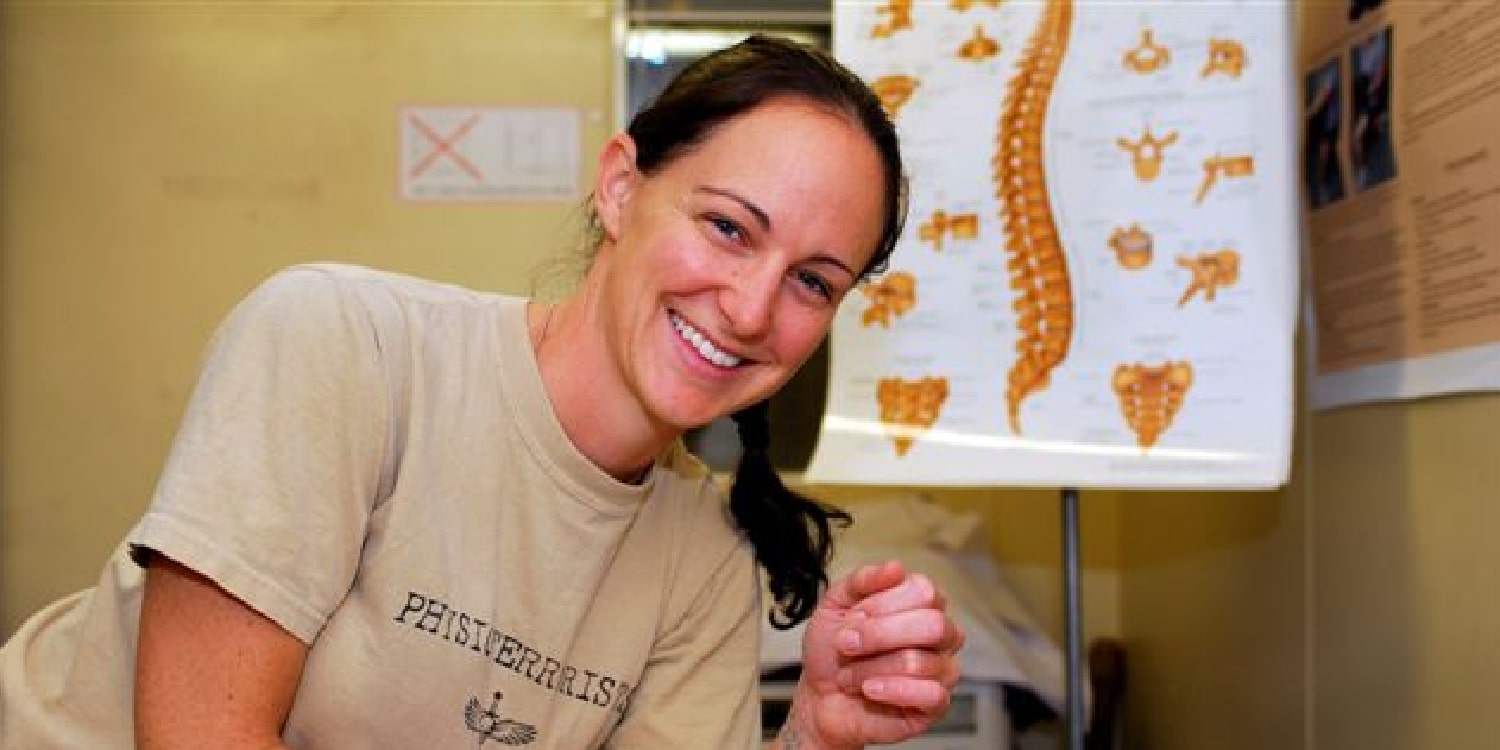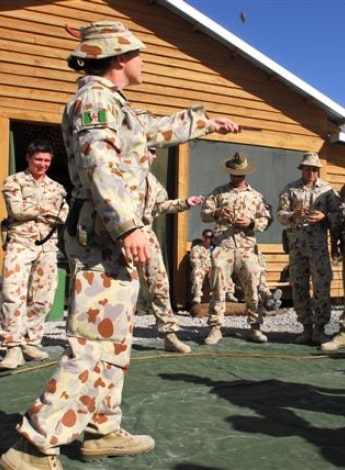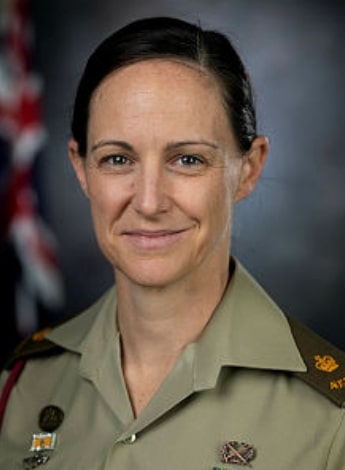
Salute to a physio on the front line

If being paid to travel, exercise and work as a physiotherapist is at the top of your career list, becoming a uniformed physiotherapist in the Australian Army might be for you.
To coincide with Anzac Day this month, Australian Army officer Major Emma Williams, a senior physiotherapist from 2nd Health Brigade based out of Canberra, discusses signing up, working out and practising physiotherapy in a war zone.
While deployed in Tarin Kot, in the Uruzgan Province in Afghanistan, Emma Williams APAM was the sole physiotherapist for around 1000 Australian troops on the ground.
Scattered across several patrol bases in the region, the soldiers would be triaged by Emma for a range of conditions when she arrived at each outpost, accompanying a supply run for water, food and ammunition.
Each day presented new challenges for Emma, who often worked in searing temperatures to ensure that troops remained fit for combat.
For nine months of 2010, Emma’s role in Afghanistan was one of preservation, providing rehabilitation on the ground so that troops didn’t have to come back in to the central base or be repatriated out.
She would provide clinical advice to the Medical Officer (GP) and Commanding Officer as to whether soldiers could stay on deployment and do their job or whether they needed to be sent home.
‘About 40 per cent of the injuries were from people overtraining in the gym because war is… the tempo is very different depending on the fighting season.
'The guys don’t necessarily patrol every day and so there’s not much else to do except get in the gym,’ Emma says.
‘So I saw a lot of overuse shoulder injuries.’
While in Afghanistan, Emma also treated troops with conditions caused by sitting in vehicles for long periods of time, wearing what was then not the best-fitting body armour.

Australian Army officer Major Emma Williams playing two-up on Anzac Day in Afghanistan.
In the intervening years, modifications have been made to body armour as part of the Army’s human systems integration work led by Defence Science and Technology Group, reducing some of the ergonomic concerns Emma saw in the field.
Emma’s rank and her role have changed over the years too.
Emma joined the Australian Army in 2005 as a Specialist Service Officer, through an undergraduate scheme that sponsors university students in a variety of fields such as medicine, teaching, nursing, engineering—or physiotherapy.
Emma was encouraged to apply for the Army after a friend of a friend, an Army dentist, suggested that she’d be a good fit due to her passion for sport and for keeping fit and active.
For the last two and a half years of her physiotherapy degree at the University of Queensland, Emma was awarded an undergraduate scholarship by the Army.
The scholarship paid her tuition, paid her a salary, covered her HECS-HELP fees and guaranteed her a job once she graduated.
All she needed to do was commit to the Army for two and a half years plus an additional year, in what is known as a return of service obligation.
‘I was really lucky to secure that scholarship. The Army doesn’t award a lot of them, so I was fortunate to get one,’ Emma says.
‘And the idea of being paid to exercise was appealing because there’s a physical component to the job where you have to pass a fitness test every six months.
'I also like to travel so that was appealing too.’
Emma began her tertiary studies at the University of Queensland in journalism (her parents were both journalists), then switched to human movement and biomedical science.
Before starting university and again before switching degrees, Emma travelled overseas, working in a pub in the UK and seeing the world.
When she came back to Australia in 2002, Emma realised she wanted to graduate with a job title, so she changed tack to study physiotherapy.
‘I didn’t want to come out as a scientist or a researcher in biomedical science and eventually I was drawn to physio.
'The musculoskeletal stuff was of interest to me, being someone who likes to be active and keep fit,’ Emma says.
‘I’ve always been physically active and into sports.’
Her physical fitness stood Emma in good stead when she turned up at Gallipoli Barracks in Enoggera, a suburb in north-west Brisbane, Queensland, on her first day as a uniformed officer in 2008.
Assigned to the 2nd Health Support Battalion’s medical unit as a Lieutenant, Emma also had to undergo officer training at the Royal Military College in Canberra—but not before some on-the- job training at Gallipoli Barracks to learn how to drill and ‘all the intricacies that are the military’.
‘They throw a uniform on you and you start work but you’ve also got to be proficient with things like weapons handling.
'In this role you’re dual-hatted—you’re an officer and you’re a physiotherapist. You’ve got additional duties in terms of the Army side of things because ultimately you’re there to be deployed.
'Most of the physiotherapists who treat Defence members are civilians; often they’re contractors and there’s also a handful of public servant positions.
‘When I graduated at the end of 2007, there were just eight uniformed physiotherapists across Australia,’ Emma says.
‘Fast-forward 16 or 17 years and there’s roughly 16 positions in the Army now, although not all are necessarily filled.
'So in that space of time the Army has doubled the number of uniformed physiotherapists.
‘We have reservists as well, civilians who might work in hospitals or private practices and who provide support for a lot of the Army sports trips or attend the big war game exercises.
'But we’re the ones who turn up in uniform every day.
'When we’re in Australia and not on operations, exercises or courses or doing other military training, we’ll work in the health centres on bases.’
Having risen through the ranks from Lieutenant to Captain, then Captain to Major, Emma has shifted her focus away from being ‘on the tools’ and has adopted a more strategic role that includes advocacy for the uniformed clinicians and bringing about better integration with civilian clinicians.

Australian Army officer and physiotherapist, Major Emma Williams.
This year saw the creation of a new role, the Senior Brigade Physiotherapist in Army, which dovetails into the formation of the 2nd Health Brigade, created to centralise the deployable medical support.
‘In 2023 I was treating patients once a week and helping out with what we call “sick parade”.
'We triage Defence personnel with acute injuries.
'In a lot of the health centres there’s a long waitlist to see physios—you can just turn up in the morning if you’ve rolled your ankle the day before or your back pain’s flared up; you can come in and get treatment and/or advice and then book follow-up appointments,’ Emma says.
‘Due to the more strategic nature of the senior role, I didn’t have a regular patient load; I was attending a lot of conferences and working groups but enjoyed getting into the clinic for the sick parades when I could.’
This year Emma is lucky enough to be sponsored again by the Army to complete her master’s degree.
Majoring in applied clinical epidemiology in a Master of Public Health through the University of Canberra, she is supported by Long Term Schooling through the 2nd Health Brigade.
Her research project is in physical health and injury surveillance in the officer cadet population at the Royal Military College in Canberra.
Although she misses the one-on-one patient interaction, her role following her year of study will be more of a population health position.
During her 15 years treating soldiers, Emma often saw injuries related to the demands of running and carrying heavy packs, particularly among new recruits and the cadet cohort.
There were a lot of ankle injuries and conditions like medial tibial stress syndrome (shin splints) and compartment syndrome, which many training establishments experience.
‘I want to effect large-scale change and I think we could do better if we set the system up to have a more integrated health workforce,’ Emma says.
‘The Joint Health Units have traditionally concentrated on treatment and one-on-one care but in my mind the gap is in preventive health, because prevention needs to occur in the training space.
‘Frequently we see loads of 30 to 40 kilograms carried in training.
'However, warfare is changing. We still train with the heavy packs on because that’s the equipment we’re issued and need to train with but we’re slowly trying to shift that mentality,’ Emma says.
‘There’s an argument that we probably need to adjust the way we’re training recruits who might never have to carry a pack, although we want our whole Defence Force to be fit and healthy.
'I’ve gone from a clinical role to more of an injury prevention role, so that’s what I’ve been trying to do in the past few years.
'We’re training for the future war, not the war from 10 or 30 years ago.’
© Copyright 2024 by Australian Physiotherapy Association. All rights reserved.





